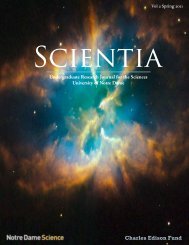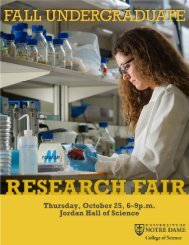Review the symposium abstracts (3.19MB PDF) - College of Science
Review the symposium abstracts (3.19MB PDF) - College of Science
Review the symposium abstracts (3.19MB PDF) - College of Science
- No tags were found...
Create successful ePaper yourself
Turn your PDF publications into a flip-book with our unique Google optimized e-Paper software.
Poster PresentationRatiometric fluorescent sensors <strong>of</strong> cysteine sulfenylationSteven BoggessChris Tom, Aaron Konopko, and Matt Stone, Dept. <strong>of</strong> Chemistry, University <strong>of</strong> MichiganAdvisor: Brent Martin, Dept. <strong>of</strong> Chemistry, University <strong>of</strong> MichiganOxidation <strong>of</strong> cysteine is an important post-translational modification that regulates manyimportant signaling pathways in cells by blocking <strong>the</strong> activity <strong>of</strong> protein phosphatases andenhancing growth factor receptor activation. Upon epidermal growth factor stimulation, NADPHoxidase is stimulated to produce hydrogen peroxide (H2O2), which acts as a second messengerby oxidizing reactive cysteines to <strong>the</strong> sulfenic acids. Recently, functionalized derivatives <strong>of</strong> <strong>the</strong>active methylene compound dimedone have been used to capture sites <strong>of</strong> sulfenylation forbiochemical and proteomic analysis. Dimedone exists in its enolate form at physiological pH(pKa 4.3), where <strong>the</strong> α-carbon reactivity is tuned to selectively react with weakly electrophilicsulfenic acids. While <strong>the</strong>se probes are valuable for biochemical studies, fluorophore conjugatesare useless for live cell imaging. In order to overcome this limitation, we present <strong>the</strong> syn<strong>the</strong>sisand activity <strong>of</strong> a family <strong>of</strong> small-molecule probes that combines dimedone with a fluorescentnaphthalene, linking <strong>the</strong> fluorescent properties to <strong>the</strong> reactive α-carbon.. These DiNaps(Dimedone Napthalene) retain <strong>the</strong> reactivity and selectivity <strong>of</strong> dimedone, and conjugate tonumerous known sulfenylated proteins. In order to induce a fluorescence change, we substituteda single α-proton with a methyl or fluorine blocking group. Blocking <strong>the</strong> α-position prevents asecond deprotonation <strong>of</strong> <strong>the</strong> dimedone upon conjugation to protein which locks it into itsdiketone form, <strong>the</strong>reby changing <strong>the</strong> electronics <strong>of</strong> <strong>the</strong> ring in order to provide a change in <strong>the</strong>excitation spectrum <strong>of</strong> <strong>the</strong> probe. Ratiometric imaging <strong>of</strong> H2O2 stimulated immature B-cellsdemonstrates <strong>the</strong> first presentation <strong>of</strong> dynamic sulfenylation in live cells.27






